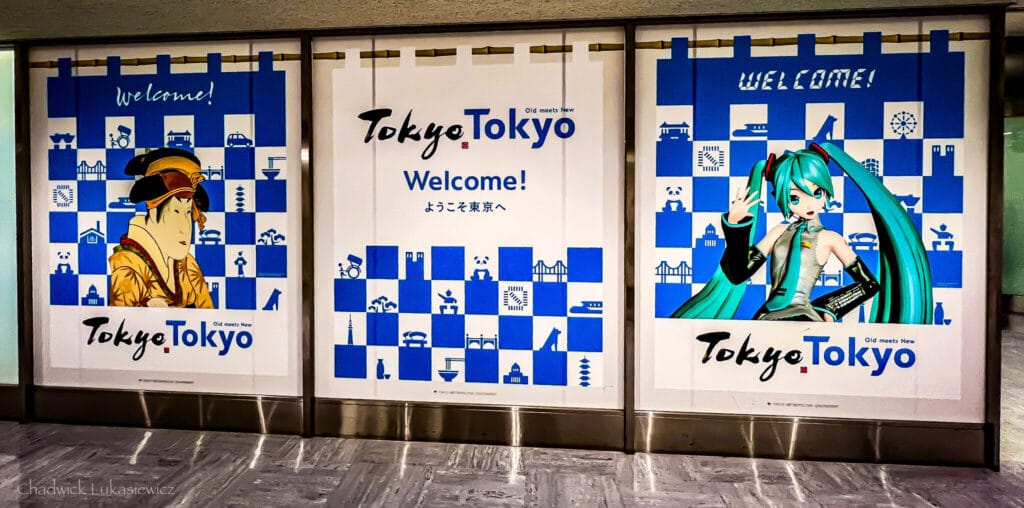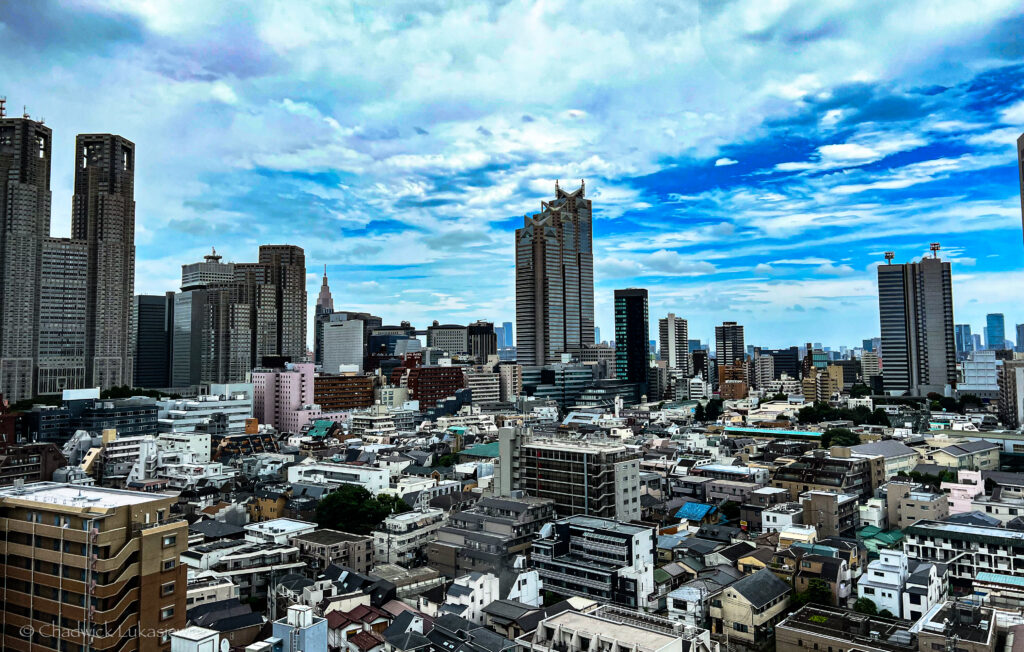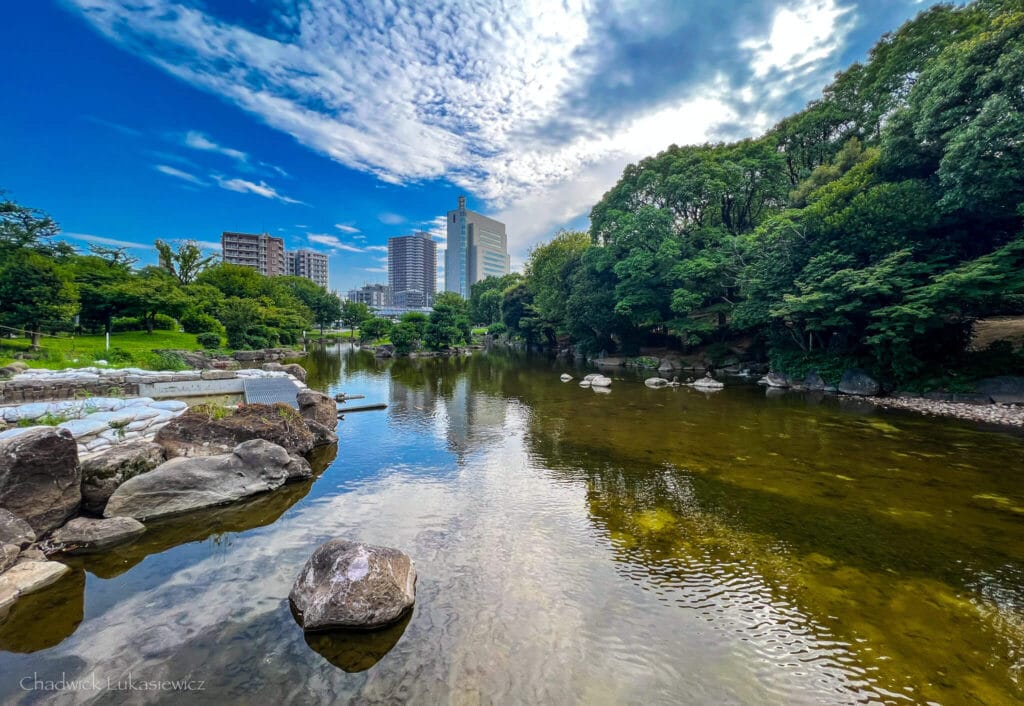You’re standing in the middle of a chaotic train station in Tokyo.
The flood of announcements echoes through the hall, fluorescent lights flicker overhead, and waves of people rush past you from every direction.
Your heart races, palms sweat, and suddenly your brain feels like it’s short-circuiting—unable to process the bombardment of sensory input.
For those of us with ADHD and AuDHD, this isn’t just another uncomfortable moment; it’s our nervous system going into full-blown overwhelm.

Hey there, fellow neurodivergent explorers!
I’m Chadwick, a Licensed Professional Counselor with AuDHD who’s solo traveled everything from the sensory tsunami of Tokyo’s Shibuya Crossing to the overwhelming vastness of Indonesia’s remote jungles.
Through years of clinical practice and globe-trotting adventures, I’ve developed some ADHD-friendly strategies that transform those “I need to escape NOW“ moments into manageable—even meaningful—parts of the journey.
So, let’s dive into my field-tested ADHD travel recovery technique for quickly resetting your system when travel overwhelm (or life…) hits.
What is Sensory Overload in Neurodivergent Travelers’ Experience?

Before diving into techniques, let’s understand what’s actually happening in our brains during sensory overload.
Unlike neurotypical travelers, those of us with ADHD/AuDHD have distinct differences in how our brains filter sensory information. Research shows we often process more environmental stimuli simultaneously, making it difficult to separate relevant information from background noise (Schulze et al., 2020).
It isn’t just about being “sensitive“—it’s about our nervous system’s threat detection center (the amygdala) going into overdrive. When this happens, our prefrontal cortex—responsible for planning, decision-making, and emotional regulation—essentially goes offline.
Sound familiar?
Some Common ADHD Travel Triggers Include:
- Transportation hubs (airports, train stations, bus terminals)
- Popular tourist attractions during peak hours
- Unfamiliar food markets with intense smells and sounds
- Accommodation transitions (checking in/out)
- Navigation in unfamiliar environments
- Complex language barriers
What makes ADHD travel particularly challenging is that we are already outside our familiar environments, making our systems more vulnerable to overwhelm and overstimulation.
The good news?
With the right skills and techniques, we can quickly reset our nervous system and return to enjoying our adventures.
Strategy 1: The Bilateral Stimulation Reset (EMDR-Inspired)
The first ADHD travel recovery technique adapts principles from Eye Movement Desensitization and Reprocessing (EMDR) therapy, where bilateral stimulation helps regulate the nervous system during trauma processing sessions (Shapiro, 2018).
Often called the “butterfly hug” in EMDR clinical practice, I modified the principles into a portable, travel-friendly version that works remarkably well for ADHD and autistic travelers experiencing sensory overwhelm.
How to Practice the Applied Butterfly Hug Technique:
- Find a relatively quiet space (even a bathroom stall works)
- Cross your arms over your chest, hands resting on opposite shoulders
- Alternately tap each shoulder while taking slow, deep breaths
- Continue for 1-2 minutes until you feel your system beginning to regulate
Why It Works: Bilateral stimulation helps activate both hemispheres of the brain, creating a physiological calming effect similar to what happens during REM sleep. The rhythmic, predictable sensory input provides an organizing external pattern that can help override chaotic environmental stimuli.
During a particularly overwhelming morning at Istanbul’s Grand Bazaar, I stepped into a quiet corner cafe and used this technique. Within minutes, I was able to return to exploring with renewed capacity—eventually discovering a hidden courtyard that became one of my favorite spots in the city.
Strategy 2: The Sensory Sanctuary Method

For ADHD and autistic travelers, creating a multi-sensory bubble of familiar, controllable stimuli can shield your nervous system from unpredictable environmental input.
How to Create Your Sensory Sanctuary:
- Put on noise-canceling headphones or earbuds
- Apply gentle pressure (weighted travel scarf, crossed arms, hands against thighs)
- Lower your gaze or close your eyes
- Play a familiar, calming sound (white noise, favorite song, nature sounds)
- Take slow breaths while focusing on the consistent sensory input
Why It Works: This technique works by reducing unpredictable sensory input and replacing it with controlled, familiar sensations (Schulze et al., 2020; Porges, 2011). The combination of pressure, sound blocking, and visual limitation creates a temporary “sanctuary” for your nervous system to reset.
Sensory-Friendly Travel Kit Essentials:
- Noise-canceling headphones (Sony WH-1000XM5 or AirPods Pro 2 for portability)
- Lightweight eye mask or Merino-wool Buff
- Favorite fidget item
- Downloaded white noise or comfort playlist
- Weighted travel scarf or compression clothing item
Pro Tip: Keep your sensory emergency kit in an easily accessible pocket of your day pack, ready for immediate deployment when you feel overwhelm approaching.
Strategy 3: The 5-4-3-2-1 Grounding Technique–ADHD Travel Edition
By systematically engaging each sense in sequence, you anchor your attention to specific, manageable environmental elements rather than processing everything at once.
How to Implement 5-4-3-2-1 Grounding:
- Identify 5 things you can SEE that are non-moving (architectural details work well)
- Notice 4 things you can TOUCH (your backpack straps, passport cover, seat texture)
- Acknowledge 3 things you can HEAR (try to find constant sounds rather than chaotic ones)
- Find 2 things you can SMELL (your lotion, cologne, local food, coffee, etc.)
- Name 1 thing you can TASTE (gum, mint, water, meal)
Why It Works: Engaging multiple sensory pathways simultaneously redirects your brain from overwhelm to present-moment awareness. What’s particularly powerful about this approach for ADHD travelers is that it provides a structured framework for focusing our attention, which can be incredibly challenging during moments of overstimulation.
When exploring and getting just a little lost in of Tokyo’s Subway, I found a pillar to stand near and systematically work through this exercise. The simple act of identifying specific sensory inputs helped transform an undifferentiated wall of stimulation into manageable pieces.
Strategy 4: The Vagus Nerve Reset
This physiological approach engages the vagus nerve—the primary pathway of your parasympathetic (“rest and digest”) nervous system. The extended exhale activates your vagus nerve, which sends signals to your brain to lower stress hormones and reduce heart rate (Porges, 2011).
How to Reset the Vagus Nerve:
- Find a quiet spot where you can sit
- Place your hand on your chest, just below your collarbone
- Take a deep breath in through your nose for 4 counts
- Hold for 2 counts
- Exhale slowly through pursed lips (as if blowing through a straw) for 6 counts
- Repeat 5-10 times
Why It Works: Studies show that breathing patterns with longer exhalations than inhalations help shift the autonomic nervous system from sympathetic (fight/flight) to parasympathetic (rest/digest) dominance (Porges, 2011; Schulze et al., 2020).
In my trauma therapy practice, I’ve found that physiological interventions often work faster than cognitive ones during moments of overwhelm. Your “thinking brain” (prefrontal cortex) is essentially offline during sensory overload, but bodily regulation techniques remain accessible, creating a bottom-up approach to calming your nervous system.
Strategy 5: The “Sensory Contrast” Technique
This innovative approach introduces an intense, controlled sensory experience opposite to the overwhelming input to interrupt the overload cycle and reset neural pathways (Mavrikaki, 2020).
How to Introduce Sensory Contrast:
- Identify which sense is most overwhelmed (visual, auditory, etc.)
- Create a strong contrast by either:
- Introducing an opposite sensory experience (e.g., cold water on wrists if overheated)
- Temporarily blocking that sensory channel entirely (e.g., closing eyes if visually overwhelmed)
- Hold the contrast for 30-60 seconds
- Gradually reintroduce normal sensory input
Why It Works: It creates a pattern interrupt, essentially rebooting the overwhelmed sensory system. The stark contrast helps give your brain a chance to reset its baseline.
During a particularly hot, day exploring Kuala Lumpur’s markets, I stepped into an air-conditioned mall and placed my cold water bottle on the back of my neck. The temperature contrast provided immediate relief and helped my system reset enough to continue exploring.
Strategy 6: The “Stuck Point” Redirect (Adapted from Cognitive Processing Therapy)
This technique integrates principles from the cognitive restructuring strategies used in Cognitive Processing Therapy (CPT). It helps identify and modify the problematic thinking patterns that emerge during travel overwhelm, particularly the automatic negative thoughts that can escalate anxiety and sensory overload (Resick et al., 2023).
How to Practically Challenge Stuck Points:
- Identify the automatic “stuck point” thought arising during overwhelm (e.g., “I can’t handle this,” “I am an embarrassment”)
- Examine the evidence for and against this thought
- Consider alternative perspectives and interpretations of the situation
- Develop a more balanced, evidence-based statement or self-belief
- Practice the new thought to strengthen neural pathways (Wilcox, 2024)
Example Scenarios & Application for ADHD Travelers:
| Problematic Thinking Pattern | Travel Stuck Point | Why It’s Problematic | Balanced Alternative |
| Jumping to conclusions | “I can’t handle this market—I need to leave immediately” | Assumes catastrophic outcome without evidence | “This is challenging but temporary—I have tools to manage it” |
| Emotional reasoning | “I feel overwhelmed, so this environment must be dangerous” | Uses feelings as evidence of external reality | “My sensory system is activated, but that doesn’t mean I’m in danger” |
| Overgeneralizing | “I got overwhelmed here, so I’ll never handle busy places” | Takes one instance and makes it a permanent pattern | “This is one challenging moment in an otherwise successful journey” |
Why It Works: The cognitive restructuring process targets the negative thinking patterns that maintain and intensify emotional distress, creating space for more adaptive coping responses even in challenging travel situations (Resick et al., 2023; Schulze et al., 2020).
After my spine fusion, I developed a habit of carrying small cards with pre-written balanced (and more positive) thoughts for common scenarios. This was invaluable when my executive function was entirely compromised by overwhelm and frustration, making it difficult to think of positive thoughts in the moment.
Strategy 7: The “Micro-Retreat” Method
Sometimes, the most effective travel recovery strategy is simply creating space between yourself and overwhelming stimuli. The time-limited nature prevents avoidance while giving your system a chance to regulate.
How to Create a Micro-Retreat:
- Give yourself permission to step away (even for 5-10 minutes)
- Find a lower-stimulation environment (bathroom, quiet corner, outdoor space)
- Set a timer for your retreat
- Implement any of the prior techniques
- Before returning, set a clear, manageable objective for your next steps
Why It Works: Temporarily withdrawing from high-stimulation environments on a precisely timed schedule to allow your nervous system to recalibrate without reinforcing avoidance patterns (Porges, 2011).
I learned that even the busiest cities have quiet pockets–hotel lobbies, museum back galleries, church courtyards, and upper floors of department stores often offer relative calm. Now, I research some “sensory safe havens” before visiting new destinations.
The timer element is crucial for those of us with time blindness—it prevents both premature return (before you’re regulated) and extended retreat (which can feed avoidance patterns).
Building Your Personal ADHD Travel Recovery System
While these techniques work individually, their power multiplies when combined into a personalized system. Here’s how to create your own ADHD travel recovery protocol:
1. Know Your Warning Signs
Our bodies often signal impending overwhelm before our conscious minds register it. Common early warning signs include:
- Increased heart rate or breathing
- Muscle tension (especially jaw, shoulders, hands)
- Irritability or emotional reactivity
- Difficulty making simple decisions
- Urge to escape or withdraw
- Heightened sensory sensitivity
Action Step: Track your personal early warning signs in a notes app or journal. What specific body sensations, thoughts, or emotions typically precede feeling overstimulated or overwhelmed?
2. Create Your Tiered Response Plan
Not all overwhelm is created equal. Try implementing a three-tier system for managing ADHD travel anxiety:
Level 1 (Mild Activation):
- Deep breathing
- Brief sensory breaks
- Hydration and quick fuel
- Movement if possible
Level 2 (Moderate Overwhelm):
- Step away from immediate situation
- Implement Sensory Sanctuary or Bilateral Stimulation
- Use grounding techniques
- Text a support person if needed
Level 3 (Severe Overwhelm):
- Full Micro-Retreat implementation
- All sensory tools deployed
- Permission to change plans if necessary
- Rest and recovery prioritized
Try using a simple traffic light system on your phone’s notes app – Green (I’m managing well), Yellow (feeling the pressure build), Red (approaching shutdown).
This type of visual check-in can help you quickly assess your state in busy airports, crowded attractions, or unfamiliar cities, prompting you to implement the right level of intervention before things escalate.
3. Build Your ADHD Emergency Reset Kit
Create a modular sensory toolkit that’s always within reach in the most accessible pocket of your day pack:
Neurodivergent Essentials (Always Accessible):
- Noise-canceling earbuds with pre-downloaded calming sounds
- Multi-sensory fidget tool (one that combines texture, movement, and pressure)
- Single-dose rescue medication if prescribed
- Emergency information card with support contacts and personal reminders
Sensory Regulation Tools:
- Temperature modulators: Cooling neck wrap and instant hand warmers
- Scent anchor: Travel-size familiar cologne/perfume or essential oil roller
- Weighted eye mask with blackout capabilities
- Deep pressure tool or piece of compression clothing
After completing my first extended, solo international trip post-AuDHD diagnosis, I refined my emergency kit to include only the most effective tools.
The reality is that when overwhelm hits, complex systems fail; simplicity and immediate accessibility are key.
My most-used item? A tiny rollerball of one of the same colognes I wear at home—one whiff instantly grounds me by providing a familiar sensory anchor amidst chaos.
Travel Recovery Isn’t Just Recovery—It’s the Foundation for Extraordinary Adventures
The ultimate goal isn’t just to survive travel as a neurodivergent adventurer but to discover how our unique minds transform our experience of the world in extraordinary ways.
When we develop effective travel recovery techniques tailored to our ADHD, we create the foundation for deeper, richer travel experiences. We can venture further, explore more authentically, and connect more meaningfully with the places we visit—precisely because we have confidence in our ability to reset when needed.
Remember: Your neurodivergent brain isn’t a hindrance to great travel experiences—it’s the source of a unique perspective that allows you to notice details, make connections, and experience moments that others might miss entirely.
The next time sensory overload threatens to derail your ADHD adventure, remember that you have a powerful set of tools at your disposal. With practice, these techniques become second nature, transforming potential obstacles into pathways for discovery.
After my spine fusion at 25, I thought my adventuring days might be forever limited…if not over. But standing atop the Gemsstock in Switzerland’s breathtaking Alps, snowboard strapped to my feet, and the vast panorama spread before me, I realized that it wasn’t about eliminating limitations—it was about developing the recovery tools that made sustainable adventure possible.
That moment of triumph came not despite my neurodivergence and physical challenges, but because I’d learned to honor them both with appropriate strategies and self-compassion.
So get ready; your next adventure awaits!
References
Bowen, D. J., & Neill, J. T. (2013). A meta-analysis of adventure therapy outcomes and moderators. The Open Psychology Journal, 6, 28-53. https://doi.org/10.2174/1874350120130802001
Mavrikaki, M. (2020, June 26). Brain plasticity in drug addiction: Burden and benefit. Harvard Health Blog. https://www.health.Harvard.edu/blog/brain-plasticity-in-drug-addiction-burden-and-benefit-2020062620479
Porges, S. W. (2011). The Polyvagal Theory: Neurophysiological Foundations of Emotions, Attachment, Communication, and Self-regulation. W. W. Norton & Company.
Resick, P. A., Monson, C. M., & Chard, K. M. (2023). Cognitive Processing Therapy for PTSD: A Comprehensive Therapist Manual (2nd ed.). New York, NY: The Guildford Press.
Schulze, M., Lux, S., & Philipsen, A. (2020). Sensory processing in adult ADHD—A systematic review. Research in Developmental Disabilities, 107, 103789. https://doi.org/10.1016/j.ridd.2020.103789
Shapiro, F. (2018). Eye Movement Desensitization and Reprocessing (EMDR) Therapy: Basic Principles, Protocols, and Procedures (3rd ed.). Guilford Press.
Wilcox, K. (2024, May 13). Learn to rewire your ADHD brain to improve cognitive skills. Psychology Today. https://www.psychologytoday.com/us/blog/mythbusting-adhd/202405/learn-to-rewire-your-adhd-brain-to-improve-cognitive-skills
While I share insights from my experience as a Licensed Professional Counselor and my personal journey with AuDHD, this content is for educational and informational purposes only. It is not a substitute for professional mental health services, medical advice, diagnosis, or treatment. Every individual’s mental health journey is unique – what works for one person may not work for another. If you’re experiencing mental health challenges, please consult with qualified healthcare providers in your area. For immediate support during a crisis, contact local emergency services or call/text 988.
Some of the links in this post are affiliate links, meaning I earn a commission if you click through and make a purchase – at no additional cost to you. As a neurodivergent traveler and mental health professional, I only recommend products I’ve personally tested and found genuinely helpful. Read our full affiliate disclosure in our privacy policy.




